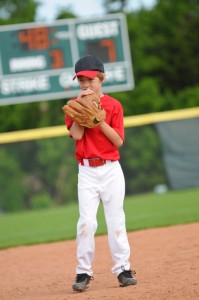 Spring has sprung and spring sports are underway. Children and teens are back on the baseball mound, track and soccer field, and while playing sports is a great source of exercise for kids, they can also cause injury and pain if children try to spring back too fast. To help keep kids healthy and active this season, Dr. Thomas Jinguji, a sports medicine doctor at Seattle Children’s Hospital, offers tips for parents and coaches to make sure pain isn’t a part of a child’s season.
Spring has sprung and spring sports are underway. Children and teens are back on the baseball mound, track and soccer field, and while playing sports is a great source of exercise for kids, they can also cause injury and pain if children try to spring back too fast. To help keep kids healthy and active this season, Dr. Thomas Jinguji, a sports medicine doctor at Seattle Children’s Hospital, offers tips for parents and coaches to make sure pain isn’t a part of a child’s season.
With more children and teens participating in recreational sports and organized activities, it’s not surprising that overuse injuries, or damage to a bone, muscle, ligament or tendon caused by stress from repetitive actions, are common. According to the American Academy of Pediatrics (AAP), half of all sports medicine injuries in children and teens are from overuse. And with longer seasons, more intensity during practices and games and more pressure to succeed, it’s no wonder Seattle Children’s is seeing an increase in these types of injuries.
“Any sport can cause an overuse injuries,” said Jinguji. “A very smart colleague once told me, ‘It’s best to build a callous rather than a blister.’ Meaning children and adolescents need to slowly ramp-up when transitioning into a sport. You wouldn’t go out and run 13 miles without training first. You begin with a mile.”
Preventing overuse injuries in kids and teens
Overuse injuries are incredibly common, especially in young athletes who specialize in one sport, according to Jinguji.
It’s important for parents and coaches to protect young athlete’s bones, ligaments and muscles by helping children warm-up, ramp-up and properly rest.
“Many coaches and athletes have been taught the saying, “no pain, no gain,” but pain that doesn’t go away isn’t good for a growing child,” said Jinguji. “Children need to understand pain, and the difference between being sore and sustaining an injury.”
Warm-up: Whether a child is in pee-wee football or select soccer, a proper warm-up is an important component of any practice or game to reduce injury. Encourage your child’s coach to provide time for warming up, and do your part by getting your child to the field, court or pool with time to spare.
Ramp-up: Too much of any sport too soon can cause injury.
“Kids are like little engines, they keep going and going. It’s important to help children prevent overuse injuries by promoting a healthy balance of activities,” said Jinguji.
For baseball players, coaches and parents should incorporate pitch counts into practices and games as well as “long toss” throwing drills prior to the season starting. These techniques will help children and teens adjust to the movements over time in a healthy and safe way, rather than overexerting their muscles with too much repetition or a new movement too soon.
The AAP also recommends cross-training to reduce injury. Running on pavement for long periods of time for many days in a row can be hard on the body. Instead of running, perform movements in different ways, train on a bike or elliptical or go swimming.
Rest: Athletes shouldn’t play through pain and overuse injuries; it will only add to the damage. Baseball players may try to change how they throw to compensate for soreness or pain, runners may run on their tip toes instead of properly striding. These types of adjustments only add to injuries and can result in further damage. It’s best to rest.
The AAP recommends athletes should take at least one day off per week from organized activity. They further recommend that child athletes take a combined two to three months off per year from a specific sport, which may be divided throughout the year. It might sound like a lot of time off, but rest and cross-training can significantly decrease the risk of an overuse injury to children and teens.
Know when to seek medical attention
Some of the most common types of overuse injuries are anterior knee pain, little league elbow, swimmer’s shoulder, shin splints and spondylolysis.
It can be hard for a child or teen to admit they are in pain. They don’t want to sit out and miss time playing, and they don’t want to appear weak to their teammates and coaches. It’s important for coaches and parents to help recognize when something could be wrong with a young athlete to prevent injury. Look for signs:
• Pain that persists and does not get better
• Limping
• Soreness or stiffness for an extended period of time – more than three to four days
• Unable to do normal, every day activities
If pain or soreness does not stop within a few days, parents should contact their child’s primary care provider for treatment.
Remember, sports and organized activities are meant to be fun for children and teens. Don’t let an overuse injury take a child out of the game. By warming up, ramping up and resting, a child is on their way to playing safely and without injury.

